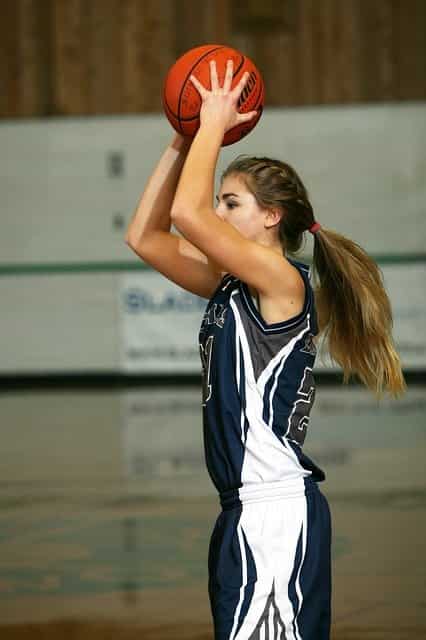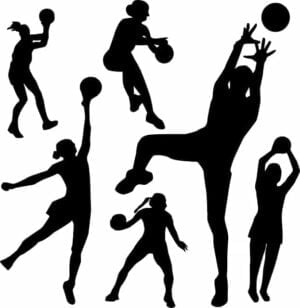DIFFERENT TYPES OF PASSES IN BASKETBALL
DIFFERENT TYPES OF PASSES IN BASKETBALL:-“Pass may be defined as a transfer of possession of the ball from one player to his/her teammates”.“Displacement of the ball from one player to another pre-determined player (teammates).”
“The quickest method of moving the ball inside the court is passing”
Basically, a pass includes a step, a wrist and finger snap, and a follow-through. Throughout the passing action, the player maintains the shoulder, hips, and knees in a loose and relaxed position. Bodyweight shifts from the rear foot to the front foot, while the accuracy of the pass is helped by using the small muscles of the fingers and thumbs. The player drops the hips slightly; bends the knees to ensure relaxation and balance, then extends the knees as the ball is released. The force-directed behind the ball is released. The force-directed behind the arm and shoulder muscles controls the appropriate distance.
When you have the ball, try to assess each situation as it develops, considering the following:
- How far away the teammate is, is he stationary or moving? Remember the distance /time relationship-the longer distance passed gives opponents more time to move in and intercept.
How far away is the opponent? If he is close, he will have less time to move his hands to intercept the pass; the further away he is, the more time he has for the interception.
- Can the pass requested by the teammate’s signal be made?
- Is an alternative pass possible and more productive?
- A skilled passer should not try to stare at the receiver or do not telegraph a pass.
- Pass the ball quickly and firmly; quick release is preferable to fast, hard movement through the air. The fast pass may involve a preparatory wind-up that will give the opponent a chance to anticipate the pass, and it may also be difficult for the team-mate catch. passes must be sympathetic.
- Whenever possible, try to pass in the horizontal plane.
- Use point to point system.
- Always give a lead pass.
- Use fake and feints.
- Do not give an extra spin to the ball.
- AMBIDEXTERITY- Must be able to pass with both hands with equal efficiency.
- Use peripheral vision
Different types of passes in basketball:- BASIC PASSES Since there are different types of passes in basketball it is unrealistic for beginning players to attempt to master every one. Beginners should concentrate on the basic passes.
DIFFERENT TYPES OF PASSES IN BASKETBALL:
Passes can be divided into two parts the basic passes and the advance passes in the basketball game
- ONE HAND PASSES
- TWO HAND PASSES
ONE HAND PASSES: –
The passes which are executed by one hand passes are classified into:-
- Push pass
- Baseball pass [Advance pass]
PUSH PASS:- One hand Push pass is also known as shoulder passes; it is most often used to get the ball into the offensive, end of the court as quickly as possible. After a rebound at the defensive basket or an interception in the defensive end of the court and also for the fast breaks.


MECHANICS OF PUSH PASS:-
- With a normal stance, the passing hand is behind the ball.
- Bring the ball back to a cocked position by the side of the body below the shoulder level, with the upper arms parallel to the floor. Passing hand behind the ball and supporting hand below the ball.
- As the throwing arm comes forward, it is a full-body movement and as a player comes through hand is still at the back of the ball as the player pushes it through with a full arm extension.
- Follow through with throwing arm outstretched after the ball. The follow-through is important to help ensure accuracy. The rear foot after the release of the wall will come forward for maintaining the body balance.
BASEBALL PASS: –
This is a pass used in the open court especially off a rebound for distance. The baseball pass is the most successful pass for initiating a fast break but a difficult pass in which to control accuracy most players discover it to be a natural way of throwing a medium or long-range pass.
- MECHANICS OF BASEBALL PASS: – The passer raises the ball to the right shoulder level with the ear, places the right hand behind the ball, and cocks the wrist with fingers spread and pointing upward. Simultaneously, move the left hand across the body to support the front of the ball and step forward with the left leg in the direction of the pass.
- The elbow of the throwing arm is flexed and away from the body. For a long pass shift the weight to the right foot, lifting the left hand as the ball is drawn behind the shoulder. The passer throws the ball by extending the elbow snapping the wrist, following through with the finger, and rotating the trunk so that weight is transferred to the forward foot.
Practice Hints: – Accuracy is difficult to achieve, therefore, it is wise to practice initially with a stationary target. Next, a cutter is added and finally, the player rebounds the ball from the basket turns, and passes to the cutter. If a goal is scored the player jumps out of bounds and passes to the cutter.
TWO HAND PASSES:-
The passes which are executed by two hands, Again two handpasses are classified into:-
- CHEST PASS
- TWO HAND BOUNCE PASS
- TWO HAND OVERHEAD PASS.
CHEST PASS: – The Chest Pass is a two-hand pass used when there is no obstacle between passer and receiver. It is, therefore, usually a perimeter pass, guard to guard or guard to forward. The Chest pass is considered the basic pass of basketball. It is a snappy, chest-high pass that travels for a distance of 15 to 20 feet in a plane parallel to the floor.
MECHANICS OF CHEST PASS
- The passer holds the ball in front of the chest with the elbows flexed and close to the side, the fingers are spread and fully extended along the sides of the ball and the thumbs are behind it.
- Snapping the wrists imparts a force to the ball as it is released. Players with weak wrists find it necessary to extend the arm in the direction of the pass. The ball is released with rotary action of hands. The direction is necessary, however, since extending the elbow telegraphs the intended path of the ball.
- Weight is transferred from the rear to the front foot when the passer is in a forward stride position after releasing the ball. If the feet are parallel the passer fakes, then takes a step forward, as the ball is released. After the release of the ball, the palm should face the floor, thumb pointing the surface and the fingers of a hand pointing the chest of the receiver.
TWO HAND BOUNCE PASS: – It is called a Bounce pass because there is a bounce on the ground before it could be received by the receiver. The bounce will be at a distance of 2/3 from the passer. The two hand bounce pass although expedient in-game situations have a tendency to be slow. Although a player may import substantial force to the pass, the speed of the ball is greatly reduced the moment it contacts the floor. The slowness of the bounce pass, as well as the possibility of passing too far from the receiver, increases the chances of interception.
MECHANICS OF TWO HAND BOUNCE PASS
- In normal stance, the passer holds the ball in front of the chest with the elbow flexed and close to the sides, the fingers are spread and fully extended along the sides of the ball and the thumbs are behind it.
- Step forward, heel ball action, do not take a long step.
- Push the ball with the thumbs, bounce the ball at 2/3rd distance in between the passer and receiver.
- Do not drop the ball, arms stretched forward wrist and fingers go for follow-through action. The ball is released with rotary action of hands.
- In follow through take a rear step forward for body balance and after the release of the ball the fingers pointing to the point of the ball bounce on the floor.
TWO HAND OVERHEAD PASS: – When this pass is applied carefully and strategically, it is difficult to intercept. The ball is thrown directly overhead or from slightly behind the head and passed to the receiver at shoulder level.


MECHANICS TWO HAND OVERHEAD PASS:
- The passer grips sides of the ball with fingers spread and thumbs behind the ball cocks the wrist and bend the elbow slightly.
- The elbows are then sharply intended above the head while the passer maintains a well balanced, body position.
- Finally, the wrists and fingers are snapped with little follow-through of the arms, step the front foot with heel ball action, body bends forward, arms are fully stretched after pass to have proper follow-through. Pass the ball to the chest level of the receiver. In general, the two-hand overhead pass is effective for:
- A tall player
- A post player, particularly when there is an opportunity to pass to a low post or to a teammate who is cutting.
- A low post
- A rebounder throwing the ball to the side
- A player receiving a pass above the head.
- A closely guarded short player passing the ball to at all post.
so here we finish full description of the different types of passes in basketball used in the game there are more according to the situation of the game
Receiving with both hands
Usually one moves toward the oncoming ball with one’s body and arms from the basic stance. When the fingertips touch the ball, the arms and the upper part of the body flex, and the impact of the ball is cushioned.
The fingers are spread and they hold the ball in such a way that the thumbs and forefingers of both hands are positioned opposite each other and are clearly behind the ball. Right from the beginning, it must be kept in mind that the ball lies on the fingers and the roots of the fingers and does not touch the whole palm of the hand. In receiving balls that arrive from the side or over the head, the cushioning of the ball is executed by a short springy movement of the stretched arms and the upper part of the body, and consequently, the movement is shorter and harder. Therefore, the elasticity of the fingers becomes essential. Only when the ball is securely gripped it is pulled to the body.
Low balls are caught from below the arms pointing diagonally downwards to meet the ball. The fingers are spread out and point downwards and the little and ring fingers are behind the ball. The springy movement is done by slightly pulling the arms and the forearms backward.
READ MORE ABOUT– After going through different types of passes in basketball you can also study about
ORIGIN AND DEVELOPMENT OF BASKETBALL
just click the link below
https://www.sportzyogi.com/origin-and-historical-development-of-basketball/


